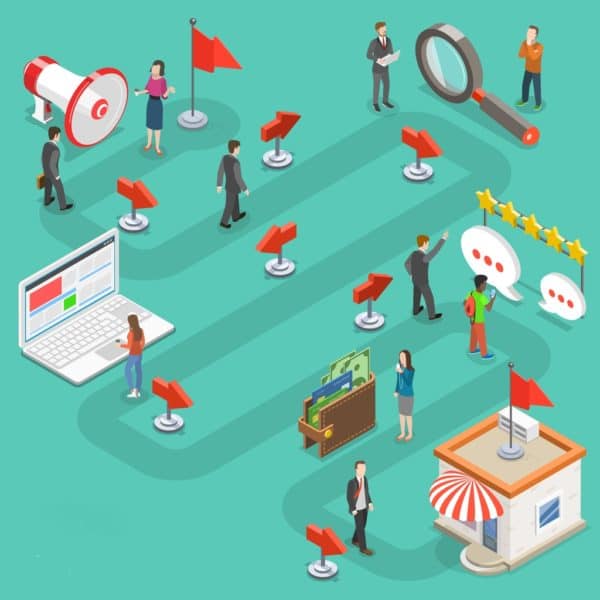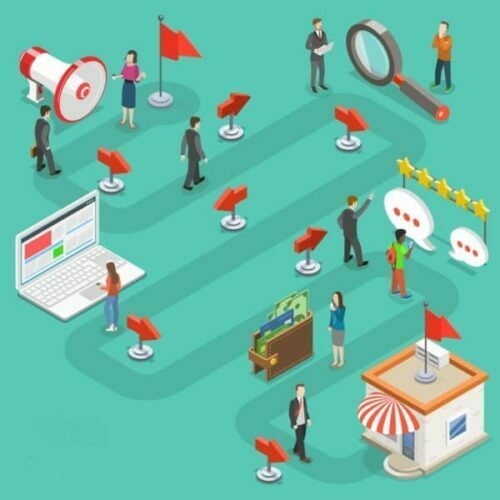A Blueprint for the Buyer's Journey
A Blueprint for the Buyer's Journey
To lead a person from a prospective customer to a faithful follower requires a plan. It’s not enough to cheer potential customers on as they travel along the buyer’s journey. A business needs a plan for each step along the way.
What is the Buyer’s Journey?
If you’ve ever bought anything before, then you are probably familiar with the buyer’s journey. You may not know the terminology, but you understand the steps. For example, if you notice your living room furniture is beginning to wear out, you’ll start thinking about buying a new set. You’ll start researching for information about what types of furniture last the longest or holds up best with kids or pets. Or you may research what styles are trending at the moment. Chances are you’ll research all angles trying to make the best decision. After you decide what type of furniture you want to purchase, you’ll probably start actively looking around for the set that fits your criteria. Finally, you settle on a brand new couch and loveseat and make the buy. You’ve just followed the blueprint for the buyer’s journey: Awareness, consideration, and Decision. Let’s take a closer look at each individual step and how it fits into your business’s marketing plan.

Steps of the Buyer’s Journey
There are three main steps in the buyer’s journey and how you position your business along each step will help determine your success.
Awareness Stage
During this step, potential customers are just becoming aware that they have a need or a problem. At this point, they may not be able to define just what they need or even what the problem is in some cases. For example, a retailer may feel the business is overwhelmed by “paperwork.” The owner notices redundancies in some of the work, a lack of efficient workflow, and that time is wasted on manual tasks. All of this hinders office efficiency. Yet, he’s not sure what is needed. The retailer is in the awareness stage.
When people are in this stage they may begin to read blogs about office efficiency, time savers, and office productivity. Whatever product or services your company offers you need to be mindful of the awareness stage. This is when you provide your audience with educational material. You’re not selling your product right now, you’re just giving information. You’re being helpful. This is a very important stage because it’s where you begin to build trust.
Consideration Stage
At this point in the journey, consumers have an idea of what products or services will help them solve their problem. They are actively pursuing more information about the specific product. In the case of the overwhelmed retailer, he would have probably learned that he could use CRM software to help with the workflow of the office. So, he’d be researching that and deciding which one would work best for his company. During this part of the journey, the customer benefits from things like e-books, whitepapers, webinars, and more detailed information. This helps the consumer come to a more thoughtful conclusion.
Decision Stage
Finally, after the research is complete, the consumer is ready to make a decision about purchasing your product. Sometimes consumers are ready to take the plunge after they’ve gone through the other two steps. However, at this stage, it helps to give potential customers a free trial or offering to help them through this final step in the journey. It shows them that you are willing to let them try out the product before making a commitment. You can also provide them with sales demos, case studies, testimonials, or statistical sheets. Any information that will show them how well your product performs will be a win for the decision stage.
Prepare for the Buyer’s Journey
Preparing for each stage along the buyer’s journey will ensure you make that critical connection with the consumer. In the end, you want the consumer to not only purchase your product but to be an enthusiastic advocate for your company. Supplying consumers with what they need along each step of the way will solidify your relationship with them and make loyal customers.
Are you ready to begin planning for the buyer’s journey? Contact Adam Lowe Creative today for more information.
Recent Posts
About the Recent WordPress Drama
As many of you have heard, there is some drama in the WordPress space right now. If you haven’t heard anything yet, consider yourself lucky to have avoided the needless drama so far. In this post, I’ll cover what is happening, who is impacted, why it’s important, how we are protecting you, and some thoughts […]
Using Sass with Pinegrow
I recently had someone ask whether Pinegrow supports Sass, so I thought I’d do a quick video demonstration. In this demo, I show you how we activate our Sass stylesheet and how we can use a simple Sass variable to change the color of a heading.
Pinegrow Countdown: Day 1 – Pinegrow Plays Nice with Others
A lot of products in the WordPress space have grown in popularity, primarily because of their open and flexible ecosystem that allows 3rd party developers to create add-ons, extensions, and libraries. Pinegrow also has a great plugin API. But I’m going to show you in this video, that in most cases, you don’t even need it.
Pinegrow Countdown: Day 2 – Pinegrow is STILL not a Page Builder
In this video, I’m going to show you why Pinegrow is different from Page Builders so you don’t fall into the trap of trying to use it like something it’s not, only to get frustrated and give up.
Pinegrow Countdown: Day 3 – Frameworks in Pinegrow
Pinegrow has built some fantastic helpers for popular frameworks. In fact, when you start a new project in either Pinegrow Desktop or the Pinegrow WordPress plugin, you’ll be asked which framework you want to choose. If you are already used to using one of the built-in frameworks, the choice will be easy. If not, this little video will hopefully help you understand what the frameworks do and how you should answer those important initial questions.



